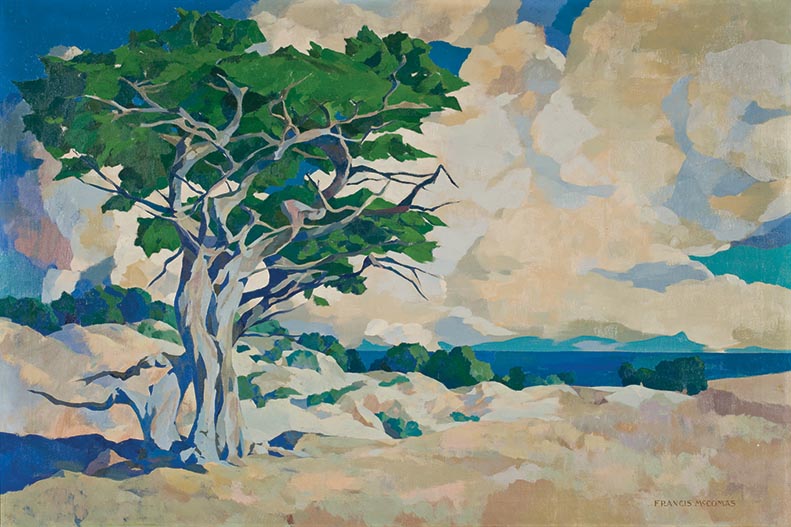
White-maned, wide-throated, the heavy-shouldered children of the wind leap at the sea-cliff.”
Robinson Jeffers penned these words to characterize the Monterey cypress in his 1925 poem “Granite and Cypress.” Jeffers knew the tree well. He planted 2,000 Monterey cypresses, Monterey pines and Australian eucalyptus trees in the area surrounding his Carmel Point home. From the window of his hand-built Tor House he could see the Monterey cypress forest on the northern end of what would eventually become the Point Lobos State Natural Reserve. This grove, and trees along the coastal strip between Cypress Point and Pescadero Point in Pebble Beach, especially the Crocker Grove, represent the last two remaining native Monterey cypress stands in the world.
The cypress trees that grace Monterey County’s shores have earned affectionate names over the years—Old Veteran, Lone Tree, Ghost Tree, Witch Tree and Ostrich Tree. Sculpted by fierce winds, their twisted trunks and angled flattened tops make each one an original. Their asymmetry and tenacity have intrigued botanists, captivated residents and visitors, and inspired well-known artists and writers. The tree is integral to the region’s aesthetic identity. The resilience of the Monterey cypress, however, belies a fragility that warrants our attention.
Botanical Treasures and Priceless Urban Forests
The two remaining native groves are botanical treasures. Although they have evolved over time, their genetic make-up is closest to that of prehistoric Monterey cypress forests that once extended all along the coast of California. Fossil evidence of cones from the La Brea tar pits and Costa Mesa in Southern California is estimated to be between 12,000 to one million years old. The marked decline of the forests was likely due to glacial melting, sea level rise, as well as changes in temperature and precipitation at the end of the Pleistocene epoch. Development has displaced other stands. Only about 30 to 40 acres of native Monterey cypresses remain, and the tree is among the rarest in the United States. The International Union for Conservation of Nature designates the species as vulnerable, which is only one step away from endangered.
Protecting native stands maintains biodiversity. And because these trees are uniquely adapted to survive in our environment, their genetic composition ultimately benefits the much larger horticultural populations that have been planted by people locally and globally over the past 150-plus years. The cypress trees that grow along the Monterey coast today serve primarily as ornamentals and windbreaks. They have important intangible benefits too, including carbon capture and pollution mitigation. As priceless urban forests, their beauty enhances property values and attracts tourist dollars.
Artistic Evolution and the Monterey Cypress
Many landscape painters who lived in or visited the Monterey coast’s celebrated artist colony in the early to mid-20th century used the cypress as a motif. The tree is a vehicle for understanding the evolution of artistic approaches during this time period, including the Hudson River School, tonalism, impressionism, cubism and abstraction.
Raymond Dabb Yelland’s interpretation of trees along Cypress Point in Pebble Beach was influenced by America’s first major artistic movement, the Hudson River School. These painters revered the grandeur of nature. Yelland’s luminist approach accentuated the light on the water, rocks, tree trunks and pathway.
Tonalist painter Arthur Mathews was influenced by James McNeill Whistler. He favored a narrow color palette, emphasis on simple shapes, and a visually flat surface to celebrate California’s beauty, including cypresses on the Monterey coast.
M. Evelyn McCormick is best known for her vibrant impressionist portrayals of adobes in Monterey, which were often accompanied by cypress trees. Working outside and focused on light, she applied paint directly to the canvas from her palette unmixed, and used short staccato brush-stokes.
In the 1920s, artists on the west coast began experimenting with new approaches. Francis McComas was among these. His large paintings of cypresses in Pebble Beach show hints of cubism in their subtle geometric substructure.
Henrietta Shore was already critically acclaimed by the time she joined the handful of abstract artists in the Monterey area in the 1930s. She captured the essence of subjects like cypress trees at Point Lobos through color, shape and texture. “To be true to nature one must abstract,” she wrote, “Nature does not waste her forms.”
Botanists, Poets, Artists and Us
Monterey cypress stands prompted the renowned American botanist Willis Linn Jepson to write in 1933 that “All thought, all contemplation, all study are here in a sufficient way eminently worth the mind’s attention. It is one tree whose full history will be highly enlightening, and it will in time easily take its place among the most well known trees of earth’s silva.” Yet even today, a good deal about the distribution, life cycle and health of Monterey cypresses—native and horticultural—remains unexamined. While the tree is able to survive periods of drought and high temperatures, just how much drought and temperature level is unknown. What science-based conservation measures are needed to ensure that the species thrives in the future?
Robinson Jeffers believed that humans are a part of nature, not masters of it. He explained his philosophy of inhumanism in his 1938 anthology, “The Wild God of the World”:
“I believe that the universe is one being, all its parts are different expressions of the same energy, and they are all in communication with each other, influencing each other, therefore parts of one organic whole…I think that one may contribute (ever so slightly) to the beauty of things by making one’s own life and environment beautiful, so far as one’s power reaches.”
“Contribute (ever so slightly) to the beauty of things.” Artists past and present have done their part to preserve the beauty of the coastal landscape for future generations. Understanding Monterey cypress trees more fully, and protecting them, is a good way for all of us to act on Jeffers’ sage advice.